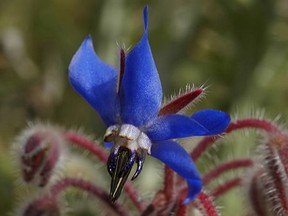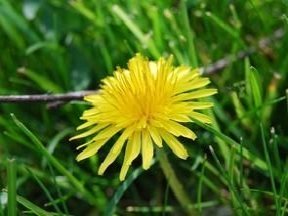Edible flowers have graced tables across cultures throughout the
centuries. It isn't a new fad or the latest fashion, and you will be
surprised just how many flowers you can eat in
salads, soups, puddings and dishes.
And for those of you who don't
think you could ever eat flowers, if you have ever eaten cauliflower,
broccoli
and artichokes, then you have eaten flowers! However, along
with edible flowers, and edible fruit flowers, there are also some
words of caution that go with this and common sense prevails.
EDIBLE FLOWERS, SAFETY AND PRECAUTIONS
Always
make sure that you know what flowers you are eating. That is, be sure
of the
identification of the plant, because eating the wrong flower is like
eating the wrongly identified mushroom; it could make you very sick, or
worse.
Also make sure that the flowers that you are eating have not
been sprayed with any insecticides or pesticides. This of course can be
overcome by growing your own and taken from locations that you know are
pesticide free, such as the fields from your own farm and homesteads.
And lastly, everything in moderation. Don't eat too many flowers all
the time.
I cannot stress more the importance of making sure
that you are eating flowers that really are edible and safe to consume.
Luckily for us, those flowers that are toxic forewarn us by usually
giving off a pungent smell and are very bitter to the taste. Despite
this however, it really isn't the right 'acid test' to take. Be very
sure of your plants, and if you don't know the difference between a
daisy and a dandelion, rather stay away from being adventurous with
edible flowers!
TWO TYPES OF EDIBLE FLOWERS
There
are two types of edible flowers:
ornamental
flowers and
herbal
flowers.
Where there is a great diversity in the taste of the various ornamental
flowers, eating herbal flowers tastes no different to their parent
plant leaves and stems.
HARVESTING YOUR EDIBLE FLOWERS
Flowers
should be picked in the cool of the day, after the dew has evaporated,
around noon.
For maximum
flavor choose flowers at their peak, and do
not pick flowers that are not fully opened, or have already started to
wilt. Once picked keep them in a cool place with the stems in water. If
you have chosen blossoms for your dish without stems then these should
only be picked about 2 - 4 hours prior to use and placed on a damp
piece of kitchen towel in a plastic bag and placed in the refrigerator.
Because
pollen can cause distress to those with allergies, and because it also
interferes with the true flavor of the flower, it is best to remove
both the pistils and the stamens, if possible. Flowers that have
multiple stamens like roses and calendulas only the petals are edible
and even these need our attention. At the base of each of these petals
is a white part that should be removed to avoid a bitter taste when
eaten. Marigolds also fall into this category.
HEALTH BENEFITS OF EDIBLE FLOWERS
Eating
flowers means that there are few carbohydrates, fat or protein in what
you are eating. However, some flowers have vitamin C or A, and contain
other trace elements such as calcium, zinc and magnesium. Borage is
said to help us forget our troubles, and calendula flowers, commonly
known as marigolds are said to bring happiness.
TOP TEN EDIBLE FLOWERS
|
|
|
BORAGE
Eating borage is said to
make us forget our troubles, gives us courage by stimulating our
adrenaline and tastes like cucumbers. The leaves or flowers can be put
in salads or sauces. Placing the flowers in ice-blocks adds interest to
drinks.
|
|
|
|
CALENDULA
The calendula is also
known as the Pot Marigold and when the petals are
dried they can be added to soups and scrambled egg to add a yellow hue
to the dishes in place of saffron. The leaves can also be brewed into a
tea.
|
|
|
|
CARNATION
Carnation (Dianthus)
petals must be separated from the calyx and the white base removed
before use as it makes eating them very bitter. What you are left with
is a clove-like taste, and the petals can be added to jellies, aspics,
salads, herb butters and cordials.
|
|
|
|
GARLAND
CHRYSANTHEMUM
The garland chrysanthemum
or edible chrysanthemum is well known in Asian
cusine. The leaves can be steamed, stir-fried or boiled and used
instead of greens. The petals can also be brewed into a tea. The petals
are tangy and go well with lamb.
|
|
|
|
DANDELION
Use the leaves raw for
salads or steam. The flowers are good both cooked and raw and make good
wine but remove the white base first and choose buds or young flowers
for the honey-like flavour. Don't eat the stems.
|
|
|
|
SCENTED
GERANIUMS
The flavor of scented
geranium flowers ranges from rose, to lemon to nutmeg and can be added
to sorbets, ice creams and desserts. The leaves can also be used and
added to soups, stews and sauces for flavor.
|
|
|
|
NASTURTIUMS
My favorite! Add leaves
and stems to any green salad for a peppery lift. Flowers can be stuffed
with cream cheese, or added to salads. Pickled nasturtium seeds make a
cheap caper substitute.
|
|
|
|
ROSES
Long used for teas and
infusions, the sweeter varieties can be found in the darker colored
roses. Miniature roses can be candied and used for cake decorating by
using egg whites and castor sugar. Rose hips make good jelly.
|
|
|
|
VIOLETS
Most violets are edible,
but some yellow species may be slightly cathartic. Flowers can be
candied with egg white and castor sugar and used for decorating cakes
or desserts. They combine well with scented geranium leaves and lemon
balm for a fragrant salad.
|
|
|
|
ZUCCHINI
BLOSSOMS
A well-known dish that is
enjoyed throughout Italy and beyond, uses the male flowers (with no
bulge underneath) of the zucchini plant. They are stuffed and fried, or
sometimes just coated in a light batter and deep-fried.
|
|
More Flowers you can Eat
| Name
of Flower |
Goes
well with ... |
| Angelica
( Angelica archangelica) |
salads,
vegetables, fruit |
| Anise
hyssop ( Agastache foeniculum) |
salads,
vegetables, pasta, fruit |
| Basil
(Ocimum basilicum) |
tomatoes,
vegetables, fish, chicken, pasta, rice |
| Bergamot
petals (Monarda didyma) |
salads,
vegetables, pasta, fish |
| Borage
(Borago officinalis) |
salads,
fruit |
| Calendula
(Calendula officinalis) |
salads,
stews |
| Catmint
(Nepeta cataria) |
vegetables,
pasta, rice |
| Chicory
(Cichorium intybus) |
salads |
| Chives
( Allium schoenoprasum) |
salads,
vegetables, sauces |
| Coriander
(Coriandrum sativum) |
Asian
dishes, salads, soups, vegetables |
| Day
lily (Hemerocallis spp.) |
Asian
dishes, soups, salads |
| Dill
( Anethum graveolens) |
salads,
fish, vegetables, dressings, pickles |
| Fennel
(Foeniculum vulgare) |
salads,
fish, pork |
Garland
chrysanthemum
(Chrysanthemum coronarium) |
salads,
vegetables, soups |
| Garlic
chives ( Allium tuberosum) |
salads,
vegetables, sauces |
| Heartsease
(Viola tricolor) |
salads,
fruit |
| Hollyhock
( Alcea rosea) |
fruit,
dessert |
| Honeysuckle
(Lonicera caprifolium) |
salads,
desserts |
| Lavender
(Lavandula angustifolia) |
chicken,
desserts, cakes, biscuits, honey |
| Lemon
(Citrus limon) |
Asian
dishes, desserts |
| Lemon
verbena ( Aloysia triphylla) |
fruit |
| Mint
(Mentha spp.) |
salads,
desserts, vegetables |
| Myrtle
(Myrtus communis) |
fruit,
fish, pork |
| Nasturtium
(Trapaeolum majus) |
salads,
vegetables |
| Orange
(Citrus sinensis) |
Asian
dishes, desserts |
| Oregano
(Origanum vulgare) |
vegetables,
fish, chicken |
| Phlox
(Phlox drummondii ) |
salads,
desserts |
| Pinks
(Dianthus spp.) |
fruit,
desserts, cakes |
| Primrose
(Primula vulgaris) |
salads |
| Rocket
(Eruca sativa) |
Asian
dishes, salads |
| Rosemary
(Rosmarinus officinalis) |
tomatoes,
lamb |
| Rose
petals (Rosa spp.) |
jam
or jelly, cake |
| Sage
(Salvia officinalis) |
Asian
dishes, rice, meat |
| Sunflower
petals (Helianthus annus) |
Asian
dishes, salads, pasta |
| Sweet
cicely (Myrrhis odorata) |
fruit |
| Sweet
violet (Viola odorata) |
salads,
desserts |
| Yarrow
( Achillea millefolium) |
salads,
vegetables |
| Zucchini
(Cucurbita pepo) |
usually
lightly battered or stuffed; but remove stamens first |
Did you find this page helpful?
Sharing is a way of saying, "Thanks!"
Follow Us and Keep Up to Date
You might also be
interested in our section on edible wild plants.
BOOKS ON EDIBLE FLOWERS

















New! Comments
Do you have something of value to add? Leave me a comment in the box below.